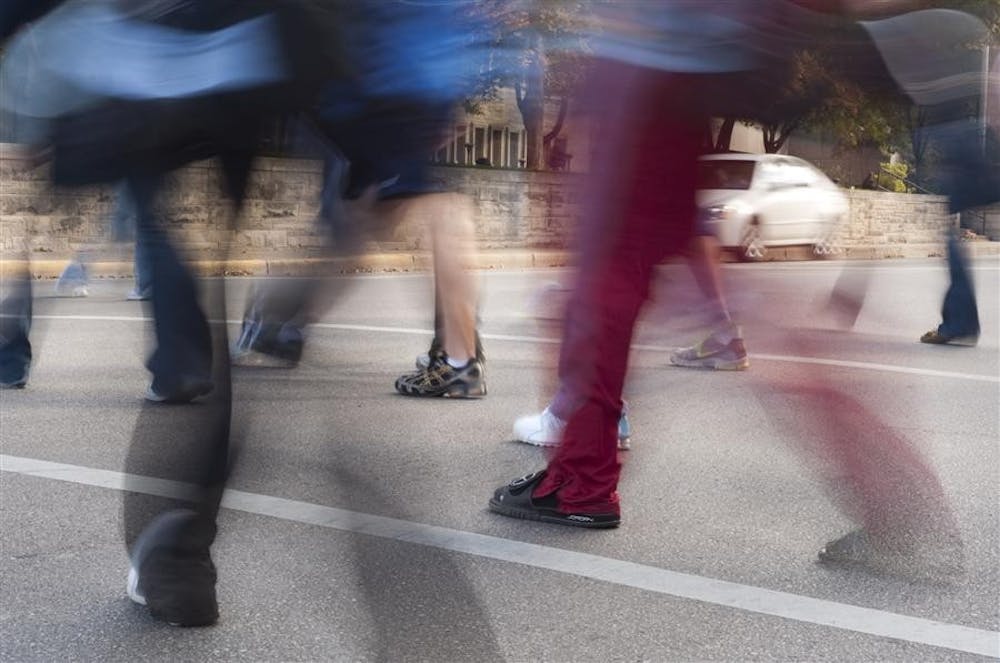While students settled into campus the week of Aug. 24 at Purdue University, officers stood at crosswalks educating pedestrians about Indiana traffic laws and giving out 100 tickets to drivers for not obeying the laws.
Purdue University and West Lafayette police officers combined forces this year to start an education program for traffic safety on and off campus in an effort to reduce the number of pedestrians injured – a program that Purdue University Police Chief John Cox said IU could imitate.
“We found out that one of the biggest misconceptions is people don’t know when to cross the street,” Cox said. “It gave students the idea that they can walk out into the crosswalks and people will stop for them, but that’s not the case.”
During the week, officers worked overtime at five different crosswalks, three of which were new and two of which had recently been repainted.
Officers partnered with city engineers to add mid-block crosswalks, or crosswalks placed in the street between intersections. Each crosswalk cost about $5,000 and was paid for by Purdue University and the city of West Lafayette.
Yield signs were also installed near the crosswalks.
Though the officers got the ball rolling, it was both a campus and city effort, Cox said.
The Purdue University Student Health Center offered to pay for educational flyers, and the residence halls and student government got involved.
“The city, University and police departments might have started the process, but the University all the way to the Mayor’s office and even student government helped with this,” Cox said.
Since the program was implemented, two pedestrians have been hit by cars. Cox said there aren’t a lot of pedestrian crashes on campus, but even one is too many.
In May, an international student died after being hit by a car near campus, which is one reason West Lafayette Police Chief Jason Dombkowski said they started the education initiative.
“We have people who come from different countries where these rules are already implemented, and then they get here and they’re terrified,” Cox said. “We’re teaching pedestrians that the liability relies on them.”
Implementing a program at IU
IU Police Department Capt. Jerry Minger said it’s hard to compare campuses and know if Purdue’s program would work at IU because the infrastructure and roadway structures are different.
However, he said if any program is going to work at IU, it’s going to be an educational program.
“There needs to be a conscious effort by pedestrians, drivers, roller bladers and cyclists,” he said.
Minger said he doesn’t like the idea of ticketing people for not following crosswalk laws. When you push people, they will often push back.
It’s much easier to get people to voluntarily follow the rules, he said.
Still, Minger said IUPD wouldn’t be opposed to helping out with an educational program, but staffing is the issue.
At the moment, IUPD is having a difficult time getting enough full-time officers to police on a daily basis, let alone having them work overtime to police crosswalks.
During the day, IUPD has only four officers working. But sometimes they are understaffed to only two or three officers, and they have to call officers in to work overtime.
At Purdue, Cox said officers face a similar situation, and they had officers work overtime in order to patrol during the first week of classes.
Purdue tries to put six officers on daily patrol instead of IU’s four.
“Rather than have police do it, I’d rather it be someone like volunteers ... something where the community is policing itself,” Minger said. “The population should take responsibility for the people.”
Mitch Rice, a member of the Bicycle and Pedestrian Safety Commission, said he agrees that Bloomington doesn’t have the ability to have officers patrol crosswalks, but he thinks IU could implement a crosswalk and signage program similar to Purdue’s.
“Enforcement doesn’t seem to work, so one of the things we’ve done is used paint to say ‘This is for the bicyclists’ and ‘This is for cars,’” Rice said. “In Bryan Park, we painted stripes on the two streets there that have no sidewalks. There are people walking up and down those streets with their children all the time. Why? Because the cars don’t go where the paint is. They just don’t do it.”
Both Cox and Dombkowski said that while they think Purdue’s system could be implemented on most campuses, programs need to be tailored to specific roadways, and the community needs to ask where crosswalks are essential.
“I think you need to look at the big picture and look at pedestrian traffic flow,” Cox said. “I think you can adapt this program to any area. You can’t put a crosswalk anywhere. You have to look at the data.”
Dombkowski, an IU alumnus, said Purdue’s campus layout is similar to IU’s.
“There are almost the same quantity of students and people crossing the street,”
Dombkowski said. “We have areas similar to Third Street, where people just cross everywhere. Our focus wasn’t on places where people cross everywhere, but instead we focused on crosswalks in hopes that people would use them correctly.”
Safety Series Part 3: Struggling for a solution

Get stories like this in your inbox
Subscribe





